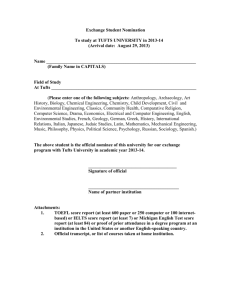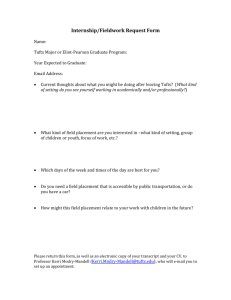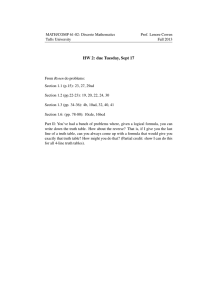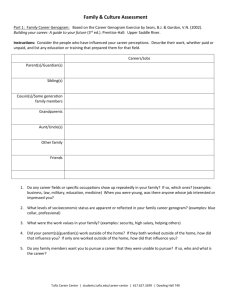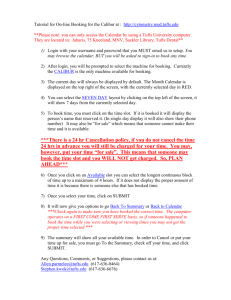Toward a cost model for system administration Alva Couch Ning Wu
advertisement
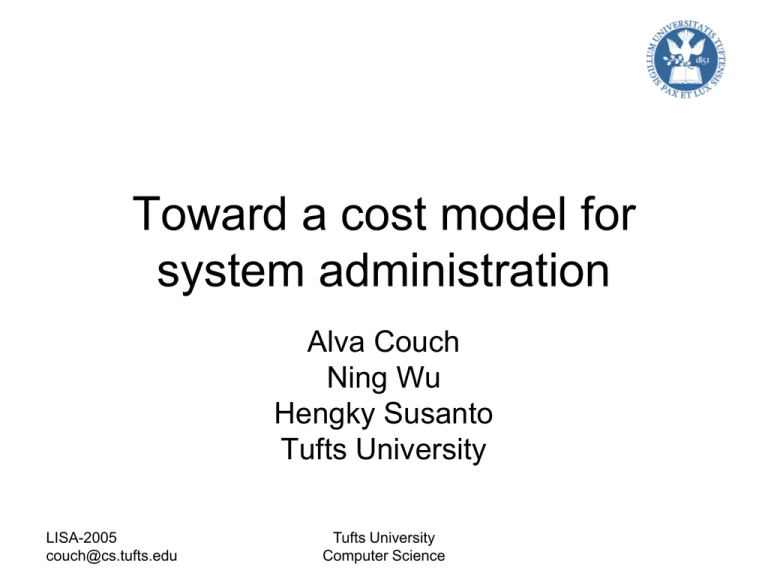
Toward a cost model for system administration Alva Couch Ning Wu Hengky Susanto Tufts University LISA-2005 couch@cs.tufts.edu Tufts University Computer Science Executive Summary Cost of SA Tangible cost of SA inc es lud d clu es in Out of SA's control Models of cost and complexity Models of task arrival and throughput in sp sp ire in to Capacity planning SA model of troubleshooting cost utilized d utilize ad zed utili le Software Engineering ire "best practice" documents Depends upon practice SA models of complexity and service cost varies with environment LISA-2005 couch@cs.tufts.edu Tufts University Computer Science Real SA performance data tickets and completions ify proportional to SA risk models Intangible cost of SA t an qu utilized Estimated waiting time System Administrator’s Summary operating systems theory software engineering theory risk assessment techniques lp to de fin help to de fine to help new metrics for complexity and process efficiency e efine new ways to compute consequences of decisions to d help e defin s est g sug new ways to improve process LISA-2005 couch@cs.tufts.edu he leads to lower cost, higher value Tufts University Computer Science leads to happily ever after “Best Practices” • Cost the least • Provide the most value • via several intangibles – homogeneity – consistency – repeatability – documentation – etc. LISA-2005 couch@cs.tufts.edu Tufts University Computer Science Patterson’s cost model • Cost of downtime ≈ cost of revenue lost + cost of work lost. • Patterson, “A simple model of the cost of downtime”, Proc. LISA 2002 • Controversial: downtime cost is “intangible”. • Or is it? LISA-2005 couch@cs.tufts.edu Tufts University Computer Science “Best” is relative! • Patching systems immediately causes more downtime than waiting for patches to stabilize. • Cowan et al, “Scheduling the application of security patches for optimal uptime”, Proc. LISA 2002. LISA-2005 couch@cs.tufts.edu Tufts University Computer Science Time spent waiting • Cost of system administration = cost of tangible assets + cost of intangibles • For most SA’s, cost of tangible assets is out of our control. • Claim 1: The intangible cost of system administration is approximately proportional to (cumulative) time spent waiting for responses to requests LISA-2005 couch@cs.tufts.edu Tufts University Computer Science Learning from real data • • • • Data source: RT queue, Tufts ECE/CS. Data duration ≈ 400 days. What is the structure of real data? Is there any easy way to describe the schedule of ticket arrivals and service? LISA-2005 couch@cs.tufts.edu Tufts University Computer Science Ticket history LISA-2005 couch@cs.tufts.edu Tufts University Computer Science Measuring time spent waiting • Time spent waiting is a function of – arrival rate: number of requests coming in – service rate: how fast requests can be processed – number of “workers” available – number of “clients” affected. • Where – arrivals include reconfigurations and refits – rate is reciprocal of expected service time LISA-2005 couch@cs.tufts.edu Tufts University Computer Science Memory • A process is memoryless if the next event does not depend upon the history of prior events. – memoryless arrivals: “Poisson process” λ = arrival rate, mean inter-arrival time = 1/λ, standard deviation of inter-arrival times = 1/λ. – memoryless service: “exponential service time”. µ = service rate, mean service time = 1/µ, standard deviation of service time = 1/µ. LISA-2005 couch@cs.tufts.edu Tufts University Computer Science Memoryless is nice (but perhaps impractical) • Memoryless arrivals: lots of identical customers behaving independently. • Arrival processes with memory: bursty behavior, such as a virus infection, spam, or DDoS attack. • Advantage of memoryless models: closedform solutions to system performance (from capacity planning) LISA-2005 couch@cs.tufts.edu Tufts University Computer Science Multiclass systems • Typical site has multiple classes of requests; some are more complex or take longer than others. • At first glance, no exponential service times. • Throw away long times (outliers); exponential service times emerge! • Claim 2: Documentation keeps requests from waiting indefinitely. LISA-2005 couch@cs.tufts.edu Tufts University Computer Science Tickets filtered LISA-2005 couch@cs.tufts.edu Tufts University Computer Science Quandary of arrivals • At first glance arrivals aren’t Poisson • But (a month of struggling later!) – correct for DST – sample over one-hour intervals – correct sampling for sparse event frequency – skip holidays • And each hour exhibits a roughly Poisson arrival rate! LISA-2005 couch@cs.tufts.edu Tufts University Computer Science Ticket creation lunch! LISA-2005 couch@cs.tufts.edu Tufts University Computer Science Ticket resolution student responsible for resolving tickets starts workday! staff arrives and handles nightly buildup in queue LISA-2005 couch@cs.tufts.edu Tufts University Computer Science Quantifying time spent waiting • Our data shows that most requests are actually accomplished at our site in (statistically) comparable times. • How does one estimate the time needed for a particular request? • One example: troubleshooting chart. LISA-2005 couch@cs.tufts.edu Tufts University Computer Science Simple troubleshooting chart no ip address end yes got an address? yes got an address? no no DHCP locally yes enabled? dhcpd running? no no Enable DHCP LISA-2005 couch@cs.tufts.edu Restart dhcpd Tufts University Computer Science yes Convert to program graph A E A yes B yes B F C D no no flow yes F yes C G G no no H D H E LISA-2005 couch@cs.tufts.edu Tufts University Computer Science Convert from graph to tree A A B E C B C D D F F G F G H E H E LISA-2005 couch@cs.tufts.edu H G Tufts University Computer Science E E E Collapse to decision tree A tB B P(C) E C tC P(D) F D P(H«|D) H tF+tG 1-P(H«|D) 0 E 0 H E E LISA-2005 couch@cs.tufts.edu 1-P(D) P(H«|¬D) tH G 0 tD+tF +tG G F 1-P(C) E Tufts University Computer Science tH 0 1-P(H«|¬D) 0 Compute expected value expected wait = tB+P(C) [ tC+P(D)[tD+tF+tG+P(H«|D)tH)+(1-P(D))(tF+tG+P(H«|¬D)tH] ] tB 1-P(C) P(C) tC P(D) 0 1-P(D) t1 tD+tF +tG P(H«|D) tH tF+tG P(E«|D) 0 0 LISA-2005 couch@cs.tufts.edu P(H«|¬D) tH p 1-p 1-P(H«|¬D) 0 t2 t3 expected wait = t1 + pt2+(1-p)t3 0 Tufts University Computer Science Notes on the decision tree • Times tX describe the capabilities of administrative staff. • Probabilities P(Y) describe the site’s characteristics and the likelihood of failures. • P(H«|D): probability of H happening given that D happened in the past • [temporal conditional probability; not Bayesian; Bayesian identities don’t hold! Another month of suffering to figure this out!] LISA-2005 couch@cs.tufts.edu Tufts University Computer Science Application: should I check the DHCP server or client first? • Answer: depends upon site characteristics. • If the likelihood is that there is a problem with X, should check X first. • Consequences of incorrect choice: increased cost. • Humans automatically compensate for poor troubleshooting order. • Claim 3: Best practices are relative to site and staff capabilities. LISA-2005 couch@cs.tufts.edu Tufts University Computer Science Bang! • The preceding method is “white box”; it measures the practice directly. • Applying the preceding argument for a non-trivial troubleshooting chart results in an exponential explosion in chart complexity. • How do we deal with huge charts or complex processes? • Answer: “black box” estimation. LISA-2005 couch@cs.tufts.edu Tufts University Computer Science Estimators from Software Engineering • Time for service is approximately a function of the number of branches in a troubleshooting chart. • Number of branches is approximately a function of heterogeneity/diversity of site and services provided. • So if we quantify diversity/complexity of service environment, we can estimate service time. • “Function points”: a way of quantifying complexity of service. LISA-2005 couch@cs.tufts.edu Tufts University Computer Science Non-product systems • We understand a great deal about “product systems” in which components act independently. • System administrators are a non-product system; they communicate and interact with each other. • Best way to estimate behavior of nonproduct systems: discrete event simulation. LISA-2005 couch@cs.tufts.edu Tufts University Computer Science A simple simulation experiment • Assume c administrators, four classes of service (from extremely short to extremely long service times), independent arrival rates for classes. • Theory: a single class system is stable if λ/cµ<1 and diverges to infinite wait time otherwise. • What happens when a multi-class system approaches the saturation point? LISA-2005 couch@cs.tufts.edu Tufts University Computer Science Diminishing returns LISA-2005 couch@cs.tufts.edu Tufts University Computer Science Divergence! LISA-2005 couch@cs.tufts.edu Tufts University Computer Science Chaos! LISA-2005 couch@cs.tufts.edu Tufts University Computer Science Running near the edge arrivals spread out bursty arrivals events in a burst, versus events spread out! LISA-2005 couch@cs.tufts.edu Tufts University Computer Science Summary • cumulative service time ≈ intangible cost of operations • computable from practice graph: function of staff expertise and site composition. • estimable from guesses for branch depth and task length for each task. • total effect estimable via discrete event simulation. LISA-2005 couch@cs.tufts.edu Tufts University Computer Science Conclusions • We can estimate the cost of practice by indirect methods. • Best practices are always site relative! • Running near absolute capacity causes chaotic increases in wait time. LISA-2005 couch@cs.tufts.edu Tufts University Computer Science What’s next? • Simulation studies of particular aspects of the practice: – communication vs. documentation, – scripting vs. cfengine • Quantification of function point models – various sizes and kinds of sites. – complexities of kinds of service. • Effects of human learning – Insignificant for repetitive tasks. – Significant for one-time tasks. LISA-2005 couch@cs.tufts.edu Tufts University Computer Science Epilogue • More questions than answers: – How can we best use this as a planning tool? – How much can we trust it? – How to fill in gaping holes in knowledge? • The potential: – better/cheaper/more valuable administrative practices. – Ability to ask cheap “what if” questions with reasonable estimates of task complexity. – better understanding of critical capacity. – happily ever after. LISA-2005 couch@cs.tufts.edu Tufts University Computer Science Questions? Alva Couch (couch@cs.tufts.edu) Ning Wu (ningwu@cs.tufts.edu) Hengky Susanto (hsusan0a@cs.tufts.edu) Tufts University Computer Science Medford, MA 02155 Note: we plan to make the discrete event simulator open source at some future time after we clean up the user interface. LISA-2005 couch@cs.tufts.edu Tufts University Computer Science
